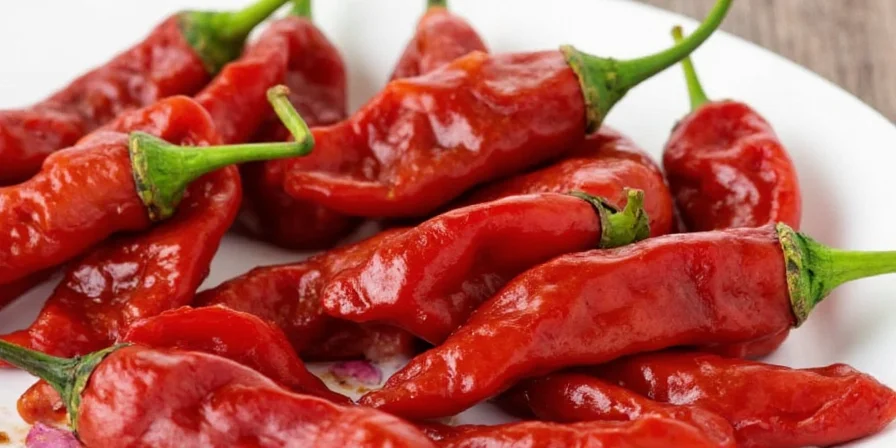Ancho Chili Peppers: The Sweet, Smoky Secret to Flavorful Dishes
Table of Contents
- What Are Ancho Chili Peppers?
- Flavor Profile and Heat Level
- How to Use Ancho Chilies in Cooking
- Top 5 Tips for Using Ancho Chilies Like a Pro
- Ancho vs. Other Common Chilies: A Visual Comparison
- Storage & Shelf Life: Keep Your Chilies Fresh Longer
- Common Myths Busted!
- Final Thoughts
What Are Ancho Chili Peppers?
If you're into spicy food but also appreciate complexity and depth, then ancho chilies might just be your new best friend. Native to Mexico, the ancho chili is simply the dried form of the poblano pepper. That’s right — this wrinkly, dark red, leathery beauty used to be a fresh green poblano before it was left to dry out under the sun like a pepper version of a tanning session gone rogue.

Botanical Background
Scientifically speaking, we’re talking about Capsicum annuum, the same species that brings us jalapeños, bell peppers, and ghost peppers. But unlike its fiery cousins, the ancho takes things down a notch while cranking up the flavor dial.
Flavor Profile and Heat Level
Let’s break this down — because yes, ancho chilies are all about breaking things down (metaphorically, of course). They bring a unique combination of flavors to the table:
- Smoky? You bet.
- Sweet? Absolutely — think raisins or prunes with a side of chocolate vibes.
- Earthy? Oh yeah.
- Heat? Mild-moderate, between 1,000–2,000 Scoville Heat Units (SHU).
This makes anchos perfect for dishes where you want a rich flavor base without blowing your guests' taste buds out of the kitchen.
How to Use Ancho Chilies in Cooking
From sauces to soups, moles to marinades — ancho chilies are incredibly versatile. Here’s how to get the most out of them:
- Rehydrate First: Soak in hot water for 20–30 minutes until soft. Some people add a splash of vinegar or citrus juice to enhance the flavor extraction.
- Blend It Out: Once softened, toss into a blender with garlic, onions, tomatoes, or whatever floats your culinary boat.
- Use as a Base: Anchos are commonly used as a foundation for salsas, adobos, and sauces due to their smooth texture when blended.
- Toast ‘Em: Lightly toast the dried chilies in a dry skillet before rehydrating to boost their smokiness. Just don’t let them burn — nobody wants bitter peppers unless you’re hosting a goth dinner party.
Top 5 Tips for Using Ancho Chilies Like a Pro
Want to impress your friends or just yourself at home? Try these pro tips:
- Remove the Seeds: While they’re not overly spicy, if you want absolute control over heat levels, take out the seeds and veins.
- Pair With Complementary Flavors: Think cumin, cinnamon, cloves, garlic, chocolate, citrus, apples, and even coffee.
- Don’t Skip the Toasting Step: Unless you’re short on time. Then do it next time. Or lie and say you did.
- Use in Ground Form Too: Ancho powder (also called chili powder) is a fantastic pantry staple. Perfect for rubs, marinades, and spice blends.
- Experiment with Desserts: Yes, really! Try ancho-infused chocolate truffles or a mole ice cream. Your sweet tooth will thank you.
Ancho vs. Other Common Chilies: A Visual Comparison
Wondering how ancho compares to other popular peppers? Here's a quick table to help you choose the right one for your dish:
| Pepper Type | Heat Level (SHU) | Flavor Notes | Best Used In |
|---|---|---|---|
| Ancho | 1,000–2,000 | Smoky, sweet, earthy | Moles, sauces, stews |
| Pasilla | 2,500–4,000 | Fruity, grassy, berry-like | Dips, braises, soups |
| Guajillo | 2,500–5,000 | Tangy, floral, tea-like | Adobo sauces, marinades |
| Jalapeño | 2,500–8,000 | Grassy, vegetal | Stuffed peppers, tacos, salsa |
| Hatch | Varies (mild to hot) | Roasty, green, peppery | Chili rellenos, sauces |
Storage & Shelf Life: Keep Your Chilies Fresh Longer
Proper storage can make the difference between vibrant, flavorful peppers and sad, brittle ones that scream “I’ve seen things.”
- Airtight Container: Store whole dried chilies in a sealed bag or jar away from light and moisture.
- Freeze Them: Yep, even dried chilies can go in the freezer for long-term storage — no thawing needed when using.
- Ground Pepper?: Keep chili powder in a cool, dark place and use within 6 months for optimal flavor.
Common Myths Busted!
Let’s set the record straight on some common misconceptions about ancho chilies:
- Myth #1: Ancho Chilies Are Super Spicy
Reality: Nope. Compared to habaneros or serranos, anchos are mellow enough for most palates. - Myth #2: You Can Only Use Them in Mexican Food
Reality: Wrong again. Try them in Mediterranean stews, Italian pasta sauces, or even Indian-inspired curries. - Myth #3: Fresh Poblanos Taste the Same as Anchos
Reality: Not even close. Drying changes the flavor profile significantly.
Final Thoughts
So there you have it — the lowdown on ancho chilies, complete with sass, science, and spice. Whether you’re a seasoned chef or someone who’s just tired of bland food, anchos deserve a spot in your kitchen.
They’re easy to work with, packed with flavor, and super forgiving — kind of like a good pair of jeans or your favorite playlist. Start experimenting, keep your pantry stocked, and don’t forget to share your creations (and maybe a few spice puns along the way).










 浙公网安备
33010002000092号
浙公网安备
33010002000092号 浙B2-20120091-4
浙B2-20120091-4